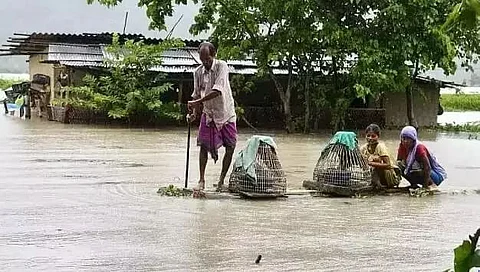
- Home
- Live Blog
- Breaking News
- Top Headlines
- Cities
- NE News
- Sentinel Media
- Sports
- Education
- Jobs

A fresh monsoon season will follow the upcoming assembly polls in Assam and expediting the work of plugging breaches in embankments is as important as holding free-and-fair elections. The challenge before the State government is to ensure that work of the flood damage repair is not disrupted or suffer from lack of monitoring the progress of work in the hullabaloo of electioneering. Failure to repair and strengthen the embankments in time adds to the magnitude of annual flood damage in the state. Last year's flood caused breaches in 212 embankments, damaged 1720 roads, 182 bridges and culverts while 90 per cent of state's 423 embankments are prone to breaches. The government has obligation to ensure that quality of construction is not compromised while expediting the restoration works. Delay in release of fund by the Central government and short span of the window that Assam gets before the onset of monsoon are often cited as the reason behind failure to complete the restoration work in time. Non-submission of utilization certificates is another reason affecting timely release of disaster fund. Underutilization of fund allocated under the State Disaster Response Fund (SDRF) on account of failure to complete the restoration working time deprives the state from its share of the National Disaster Response Fund (NDRF). States can request financial assistance for disaster management through the NDRF by submitting memorandum to the Central government after they exhaust the SDRF allocations. The SDRF and NDRF are now covered under the State Disaster Risk Management Fund (SDRMF) and National Disaster Risk Management Fund (NDRMF) created at the recommendation of the 15th Finance Commission to cover both relief and mitigation and provisions made under the Disaster Management Act. The principle of disaster fund utilization is to ensure that the preparedness of the state and early warning system are improved to reduce the risk and consequent damage. The Finance Commission is of the view that the mitigation fund created should be used for those local level and community-based interventions which reduce risks and promote environment-friendly settlements and livelihood practices. Failure to utilize the SDRF fund fully by Assam was also reflected in SDRF allocations in subsequent years as previous finance commissions employed the expenditure-driven methodology to determine the allocations. The current finance commission has replaced this methodology with a combination of capacity (as reflected through expenditure), risk exposure (area and population) and hazard and vulnerability (risk index). It has also recommended that allocation for SDRF and NDRF for 2021-22 be retained at the level of 2020-21 and thereafter be set to increase by 5 per cent annually from 2022-23 to 2025-26. As expenditure remains a key component in the new methodology, Assam improving its capacity to utilize the earmarked fund for disaster management work will determine the size of the future allocations under SDRMF.
The commission recommended dividing state allocation for SDRMF into State Disaster Risk Fund and State Disaster Mitigation Fund, "which together address the full cycle of disaster management needs – response and relief, recovery and reconstruction, preparedness and capacity-building and mitigation. The SDRF component is 80 per cent of the total SDRMF, while the SDMF component is 20 per cent of the allocation. Within the SDRF allocation of 80 per cent, there are three sub-allocations: Response and Relief (40 per cent), Recovery and Reconstruction (30 per cent) and Preparedness and Capacity-building (10 per cent). While the funding windows of SDRF and SDMF are not inter-changeable, the finance commission has allowed flexibility for re-allocation within the three sub-windows of SDRF. The commission's acknowledgement of the needs of the states to rebuild assets and livelihoods, several windows have been opened for flood and erosion ravaged Assam in respect disaster funding. The recommendation for setting up a Recovery and Reconstruction Facility, both within the SDRF and NDRF, and earmarking 30 per cent of the resources available with these two funds for this purpose, the commission, hopes will help people affected by disasters on a long-term basis. The state also needs to act on another important recommendation of the making panchayats and other local bodies the nodal agency for relief and rehabilitation. The commission has rightly observed that government agencies taking sole responsibility for disaster preparedness, rescue, relief, and reconstruction activities without providing adequate scope for local participation has increased people's dependence on the government machinery and diminished the capacity of local communities to cope with natural disasters. Unfortunately, the twin issues of flood and erosion fade out from the public discourse after the floodwater recedes in the affected districts. People asking the political parties to make it a major poll plank will also mount pressure on the departments concerned to expedite restoration works. Electioneering for the upcoming elections brings an opportunity for informed debates and discussion by parties and candidates for a permanent solution to the twin problems.